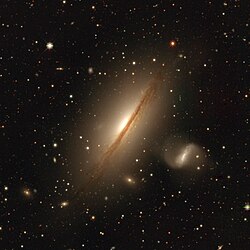Astronomy:NGC 5078
From HandWiki
Short description: Spiral galaxy in the constellation Hydra
| NGC 5078 | |
|---|---|
 legacy surveys image of NGC 5078 and IC 879 | |
| Observation data (J2000 epoch) | |
| Constellation | Hydra |
| Right ascension | 13h 19m 50.0s[1] |
| Declination | −27° 24′ 36″[1] |
| Redshift | 2168 ± 6 km/s[1] |
| Distance | 94 Mly[2] |
| Apparent magnitude (V) | +11.8[1] |
| Characteristics | |
| Type | SA(s)a[1] |
| Apparent size (V) | 4′.0 × 1′.9[1] |
| Other designations | |
| PGC 46490[1] | |
NGC 5078 is a spiral galaxy in the Hydra constellation, approximately 94 million light-years away from Earth.[2] It has a diameter of 127,000 light-years and is probably a member of the NGC 5061 group.[3] The dust lane of NGC 5078 is warped, probably by interaction with the nearby galaxy IC 879, which is itself distorted into an 'S' shape by the interaction.[4] At the presumed distance the two galaxies would have a minimal separation of about 61,000 light-years.[3] For comparison, the Large Magellanic Cloud is about 160,000 light-years from the Milky Way.
One supernova has been observed in NGC 5078: SN 1999cz (type Ic, mag. 16).[5]
References
- ↑ 1.0 1.1 1.2 1.3 1.4 1.5 1.6 "NASA/IPAC Extragalactic Database". Results for NGC 5078. http://nedwww.ipac.caltech.edu/.
- ↑ 2.0 2.1 "Best of AOP - Galaxies: NGC 5078". NOAO. https://www.noao.edu/outreach/aop/observers/n5078.html.
- ↑ 3.0 3.1 Bratton, Mark (2011). The Complete Guide to the Herschel Objects: Sir William Herschel's Star Clusters, Nebulae and Galaxies. Cambridge University Press. p. 278. ISBN 978-0521768924. https://archive.org/details/completeguidetoh00brat.
- ↑ "NGC 5078 and its distorted companion IC 879". http://ftp.aao.gov.au/images/captions/aat099.html.
- ↑ Transient Name Server entry for SN 1999cz. Retrieved 31 March 2023.
External links
 |

